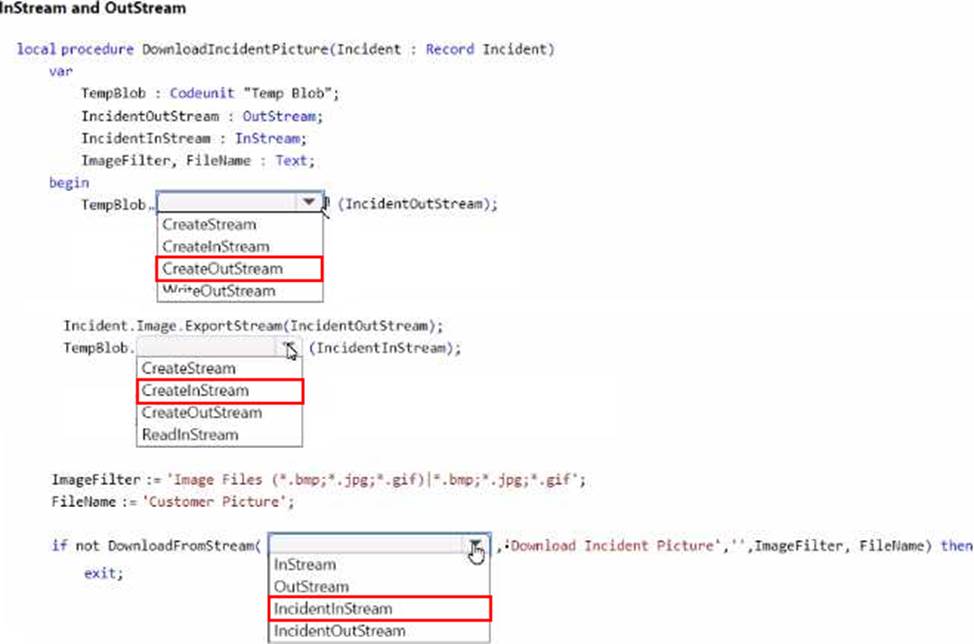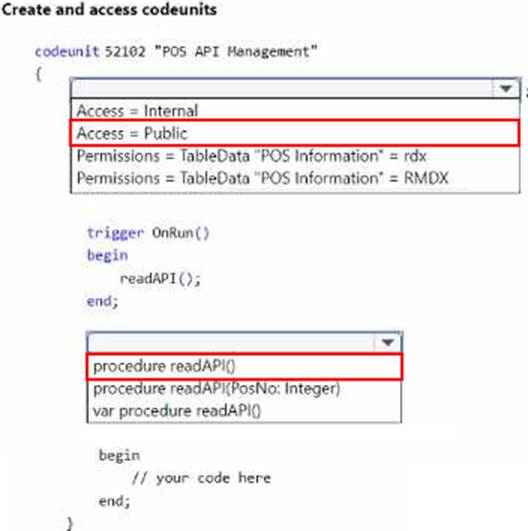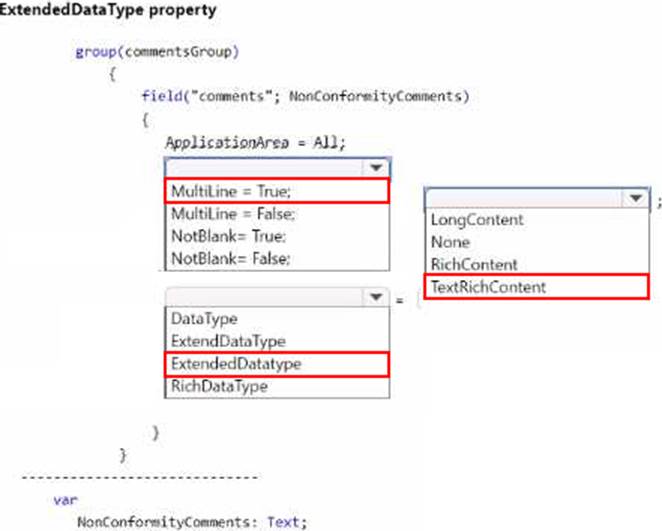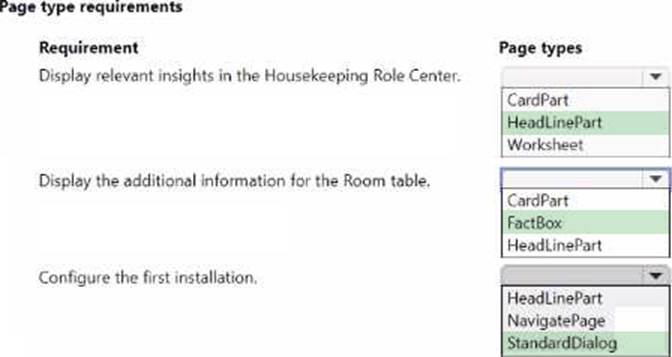Microsoft MB-820 Microsoft Dynamics 365 Business Central Developer Online Training
Microsoft MB-820 Online Training
The questions for MB-820 were last updated at Feb 15,2025.
- Exam Code: MB-820
- Exam Name: Microsoft Dynamics 365 Business Central Developer
- Certification Provider: Microsoft
- Latest update: Feb 15,2025
Topic 1, Case Study Alpine Ski House
Overview
Alpine Ski House is a company that owns and operates hotels, restaurants, and stores.
Currently, the company uses the following software and interlace:
• Property management software (PMS) to manage hotel rooms
• On-premises accounting software to generate sales invoices and create purchase orders
• An API that allows restaurants and stores to obtain necessary information
Restaurants and stores use standalone software for point of sale (POS) devices. Each day, the POS terminals generate a text file of sales data and save the files in a serval folder. An account assistant must manually import the files to the current software tables to be processed by the system.
The general manager receives several reports monthly from department managers. The reports take too much time to prepare.
The company is moving from a different system to 8usiness Central online to manage the whole company.
The company plans to increase efficiency in every department by using APIs to obtain or share information between the different systems.
Each department involved in purchasing must be able to make purchase requests automatically and easily. The departments do not need access to the full ERP management system.
Alpine Ski House requires the development of several extensions for the planned improvements.
Business Central design patterns must be used to develop all extensions.
Alpine Ski House must develop the following pages:
• Pages that provide multiple configurations in a multistep dialog, like a wizard, to provide required information when the extensions are first installed
• Department-specific Role Center pages to show relevant information and pages with additional information
The IT department plans to use Power 61 to analyze departmental information. The database must be configured to provide optimal performance.
The housekeeping department requires the following to increase efficiency and help avoid data entry errors:
• A Housekeeping Role Center to minimize navigation to relevant areas In Business Central online and to show relevant information in it
• Pages to embed into a new Room page to show additional information about the Room entity
• A table named Room Incident for the housekeeping team to enter room issue information
• A Housekeeping canvas app that connects to an extension
The department requires the development of an extension with a new API page named RoomsAPI.
• The housekeeping team will use RoomsAPI to publish room details, update when work is complete, or provide repair notifications from the canvas app.
• This custom API page must expose a custom table named Rooms and have an ID 50000. The table must be able to update from the PMS.
The PMS team must know the end to connect to the custom API.
• A developer provides the following details for the API page:
APIPublisher = ‘alpine’;
APIGroup – ‘integration’;
APIVersion – ‘v2.6’;
fntityName ■ ‘room’;
EntitySetName = ‘rooms’;
• The extension must be published in Business Central online and include a list page named Room List that includes all hotel rooms.
• Installation or updates to this extension must meet the following requirements: o Some web services must be published automatically.
o The version of the specified application’s metadata must be obtained in AL language.
o The code required to perform tasks cannot be accessible from other parts of the application.
The Room Incident table information must include the following fields:
• Incident entry: An incremental number
• Room No.: A room from the Room table
• Incident Date: The work date
o The table definition in the Room Incident table must autofill the Incident Date when the housekeeping team inserts a new record.
o The value for Incident Date must be the work date configured in the Business Central online client.
• Status: Includes the following options lo identify the status of the incident:
o Open: When the Room Incident is created
o In Progress: When someone starts repair work
o Closed: When the incident is solved
• Incident Closing Date: Auto-updating field (when the status passes to Closed, the field will update with the work date)
• Incident Description: Text
• Image. Media data type
o The stored picture must be downloadable from a menu action.
o A Room Incident page must be developed to contain the download action.
To increase efficiency, the new system must manage the generated data from the restaurants and stores directly by using the API on the POS terminals.
• The company requires a code unit called from a job queue to read the information from the POS terminal APIs.
• The POS terminal information must be stored in a table named POS Information, have an ID 50100. and be editable on a page.
• The account manager requires an option on the menu of the page to run the process manually.
To analyze the information received from the POS terminals, the company requires:
• A custom API named ticketAPI to export the information to Power BI
• Use of the Read Scale-Out feature to improve database performance
The purchasing department requites a new entity in Business Central online to log non-conformities of goods received from vendors.
The entity must be set up as follows:
• The non-conformity entity must have two tables:
o a header with common information
o one or more lines with the detailed received items that are non-conforming
• The entity requires a page named Non-conformity and a subpage named Non-Conformity Lines to store the information.
When a purchase order with incorrect quantity 01 quality issues is received, the entity must create a non-conformity document in the system.
The following information must be nick the document:
• Non-conformity Number: must use the No.
Series table from Business Central online to manage this field and use these features:
o Alphanumeric values
o Number format that includes "NO and the year as part of the number: for example, NC24-001
• Non-conformity Date: stores only the creation date
• Vendor No.: stores the number of the vendor that sent the items; only vendors from the company must be included
• Owner: code of an employee defined in the company
• Receipt No.: must meet the following conditions:
o Be an existing receipt No.
o Be received from the vendor indicated in the Vendor No. field
• Comments: can include comments with rich text and pictures to illustrate quality problems
• Status: includes nonconformity statuses, such as:
o Open
o Notified
o Closed
• Lines must contain the following details:
o Item No.: item received (for existing inventory items only)
o Description: item description
0 Quantity: non-conforming quantity
0 Non-conformity Type:
■ Quality
■ Quantity
■ Delivery date
The serial numbers of the non-conformities and the period in which they can be created must be in a configuration table and its corresponding page to allow them to be modified for the users.
HOTSPOT
You need to download a stored picture from the Room Incident page.
How should you complete the code segment? To answer, select the appropriate options in the answer area. NOTE: Each correct selection is worth one point.
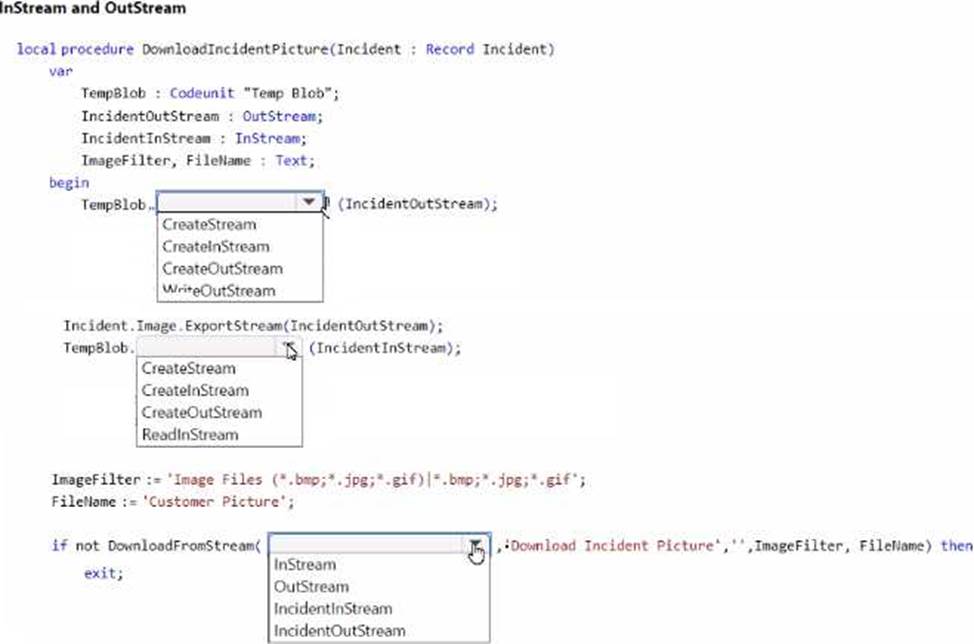
HOTSPOT
You need to create the codeunit to read the POS terminal APIs.
How should you complete the code segment? To answer, select the appropriate options in the answer area. NOTE; Each correct selection is worth one point.
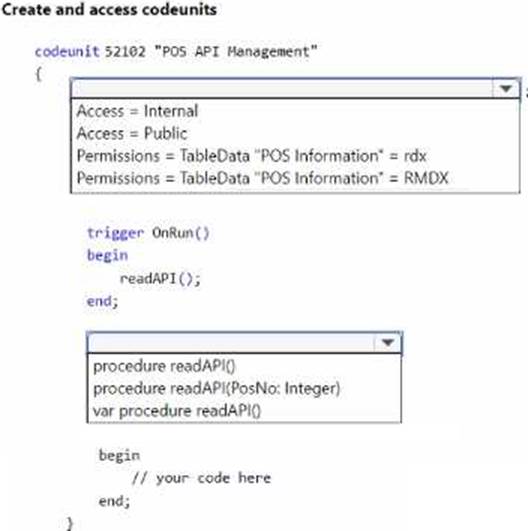
HOTSPOT
You need to define the properties of the comments field of the Non-conformity page.
How should you complete the code segment? To answer, select the appropriate options in the answer area. NOTE; Each correct selection is worth one point.
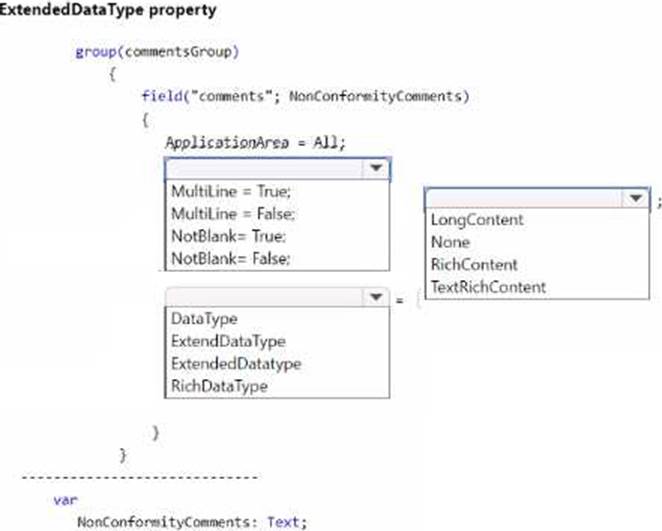
You need to define the data types for the fields of the N on-conformity table.
Which two data types should you use? Each correct answer presents part of the solution. NOTE: Each correct selection is worth one point.
- A . Integer for the N on-conformity Number field
- B . Date Time for the Non-Conformity Date field
- C . Char for the Non-Conformity Number field
- D . Date for the Non-Conformity Date field
- E . Code for the Non-Conformity Number field
HOTSPOT
You need to create the Install codeunit that is requited in the extension used for installing or updating the Housekeeping app.
Which data type or declaration should you use? To answer, select the appropriate options in the answer area. NOTE; Each correct selection is worth one point.

HOTSPOT
You need to select the appropriate page types to solve the reporting requirements.
Which page types should you use? To answer, select the appropriate options in the answer area. NOTE; Each correct selection is worth one point.
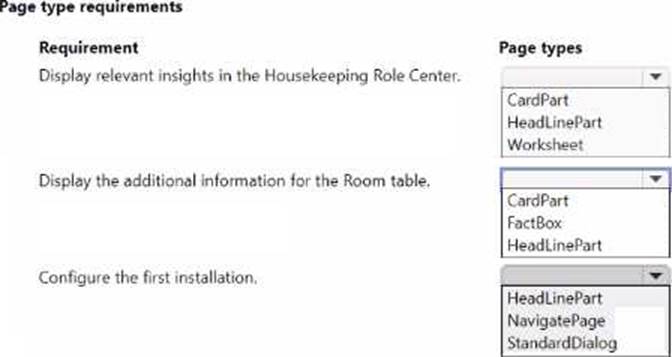
Topic 2, Contoso, Ltd.
Overview
Contoso, Ltd. Is a sales company in the manufacturing industry. It has subsidiaries in multiple countries/regions, each with its own localization. The subsidiaries must be data-independent from each other. Contoso. Ltd. uses an external business partner to manage the subcontracting of some manufacturing items. Contoso. Ltd. has different sectors with data security between sectors required. Contoso, Ltd. uses Business Central online as the main ERP for financial. sales, purchase, warehouse, and manufacturing processes. It has employees that use the Business Central web application and external applications. The company has a custom external mobile app under development
The IT department and its partners installed custom extensions to satisfy the company’s requirements where the functionality is not available natively.
Contoso. Ltd. interacts with external services provided by customers and partners. Different applications interact with SOAP and OData endpoints exposed from Business Central.
An external business partner of Contoso, Ltd exposed a REST API for receiving details about new subcontracting orders and for sending the planned release date of each subcontracting order received.
Contoso. Ltd. has not activated the monitoring of the tenant and has no internal telemetry for its apps.
Custom reporting must be created to meet the requirements of the different departments.
Contoso, Ltd. has the following tenant management considerations:
IT department
• The IT department requires the ability to monitor the tenant to prevent performance problems and detect possible anomalies.
• The IT department plans to use Azure Application Insights and Log Analytics to inspect the ingested telemetry signals.
• All tenant upgrades are automatically handled by Microsoft. The IT department does not check for update availability or for tenant-related notifications.
• The IT department has not configured the receipt of tenant-related notifications from the Business Central admin center.
External business partner
• The external business partner must add custom telemetry to an application created for Contoso. Ltd. to monitor a business process.
• Custom telemetry signals for the application must be visible only on the partner’s telemetry.
SOAP
• Contoso, Ltd. plans to dismiss using the SOAP protocol for integrations.
• Contoso, Ltd. must be able to detect if external applications are using its Business Central SOAP endpoints.
Issue
The Business Central tenant is upgraded by Microsoft to a new major version during the night.
Users report that one of the Contoso. ltd. extensions disappeared from the tenant The IT department confirms that the extension is still published.
Contoso. Ltd. plans to create a custom mobile application that has the following requirements:
• The app must be used by employees to check item details from the ERP in real time and to report issues that occur during the manufacturing process.
• An AL extension must be created for handling archived issues.
• Business Central development guidelines must be followed when implementing modules.
• A module must be implemented for the reporting and tracking of issues information. You plan to call this module Issue Management The module must expose a method nan Postlude.
• Code modifications will be required over time.
• The Issue Management process must be split into two extensions: o ISSUE BASE: main extension
o ISSUE EXT: second extension with dependency from ISSUE BASE
• In the version 1.0.0.0 of the ISSUE BASE extension, you plan to create an Issue table that contains a global Decimal variable named Issue Total.
• In the version 1.0.0.0 of the ISSUE BASE extension, you plan to define a table named Issue Category with a Description field defined as follows:
field (2; Description; Text[SG])
{
DataClassificstion * CustoaerContent;
>
• The Issue table defined in ISSUE BASE extension contains a Clone procedure defined as follows: procedure Corte () begin end;
• In the ISSUE EXT extension, you create a table extension object of the Issue table.
• The table extension object of the Issue table must access the Issue Total: Decimal variable. After weeks of usage, you discover that you must remove the Description field and the Clone procedure because they are no longer required.
In a new version of the ISSUE BASE extension, you create a new Issue Type table. You must move data row by row from a previously obsolete Issue Category table to the new Issue Type table. Because a large amount of data must be moved, you must write an Upgrade codeunit by using the DataTransfer object.
The IT department creates a custom API for exposing the custom Issue table. The API provides an action for copying an issue to a new table. The action is defined as follows:
(Service Enabled]
procedure Copy (vary action Context: WebServiceActionContext) begin
end;
Contoso, Ltd. must create an API in Business Central to expose item details to the mobile application.
• The API must have the lowest possible impact on the production environment when used during working hours.
• The API must only support Get operations.
A user of the ISSUE BASE extension in Business Central reports a problem.
To debug the problem, snapshot debugging with the following configuration was activated:
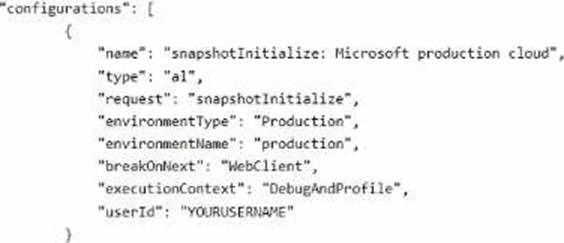
You discover that the debugging is not triggering.
Contoso, Ltd. must connect Business Central to the external API provided by the business partner. This will be used for the partner to send the details of new subcontracting orders to fulfill the sales demand, and for receiving the planned release date of each order sent.
The integration requirements are as follows:
• The business partner will provide a REST API secured with basic authentication. Credentials to access the API will be shared with Contoso, ltd.
• The API for sending subcontracting orders must be called by sending an authenticated POST request to the given endpoint.
• The API for retrieving the order no. and planned release date of each subcontracting order responds with the following JSON:
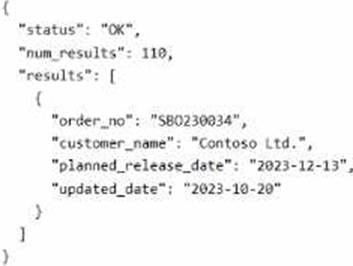
Each order no. must be retrieved.
DRAG DROP
You need to handle the removal of the Description field and the Clone procedure without breaking other extensions.
Which three actions should you perform in sequence? To answer, move the appropriate actions from the list of actions to the answer area and arrange them in the correct order. NOTE: More than one order of answer choices is correct. You will receive credit for any of the correct orders you select.

You need to determine If you have unwanted incoming web service calls in your tenant during the last seven days.
Which two KQL queries should you use? Each correct answer presents a complete solution. NOTE: Each correct selection is worth one point.
A)
![]()
B)
![]()
C)
![]()
D)
![]()
E)
![]()
- A . Option A
- B . Option B
- C . Option C
- D . Option D
You need to call the Issue API action from the mobile application.
Which action should you use?
- A . POST/issues (88122e0e-5796-ec11-bb87-000d3a392eb5yMicrosoit.NAV.copy
- B . PATCH /issues {88122 eOe-5796-ed 1 -bb87-000d3a392eb5)/Mkrosotl.NAV.Copy
- C . POST /issues (88122e0e-5796-ec11 -bb87-000d3a392eb5)/Copy
- D . POST /issues (88122e0e-5796-ec11 -bb87-000d3a392eb5)/copy
- E . POST/issues(88122e0e-5796-ec11-bb87-000d3a392eb5)/MicrosoftNAV.Copy
You need to determine why the extension does not appear in the tenant.
What are two possible reasons for the disappearance? Each correct answer presents a complete solution. NOTE: Each correct selection is worth one point.
- A . The extension was published as a DEV extension.
- B . The extension was not compatible with the new version within 60 days of the first notification.
- C . The extension was published as PTE. and the Platform parameter was not updated in the application file.
- D . The extension was published as PTE. and the Platform and Runtime parameters were not updated in the application file.
- E . The extension was not compatible with the new version within 90 days of the first notification.
Latest MB-820 Dumps Valid Version with 56 Q&As
Latest And Valid Q&A | Instant Download | Once Fail, Full Refund

